Business Statistics Assignment: SPSS Output Interpretation & Analysis
VerifiedAdded on 2022/12/19
|8
|1540
|24
Homework Assignment
AI Summary
This business statistics assignment solution provides a comprehensive analysis of SPSS output, focusing on correlation analysis, hypothesis testing, and interpretation of results. Part A examines the relationship between gender, attitude toward a brand, and purchase intention, using correlation analysis to assess the strength and direction of these relationships. Part B investigates the impact of income level on brand awareness, employing cross-tabulation and Chi-Square tests to determine if a significant relationship exists. Finally, Part C explores the influence of gender and age on attitudes toward a brand, utilizing descriptive statistics and tests of between-subjects effects to identify significant factors. The assignment provides detailed interpretations of the statistical findings, including the acceptance or rejection of null hypotheses. The provided solution demonstrates how to interpret and analyze statistical data relevant to business scenarios.
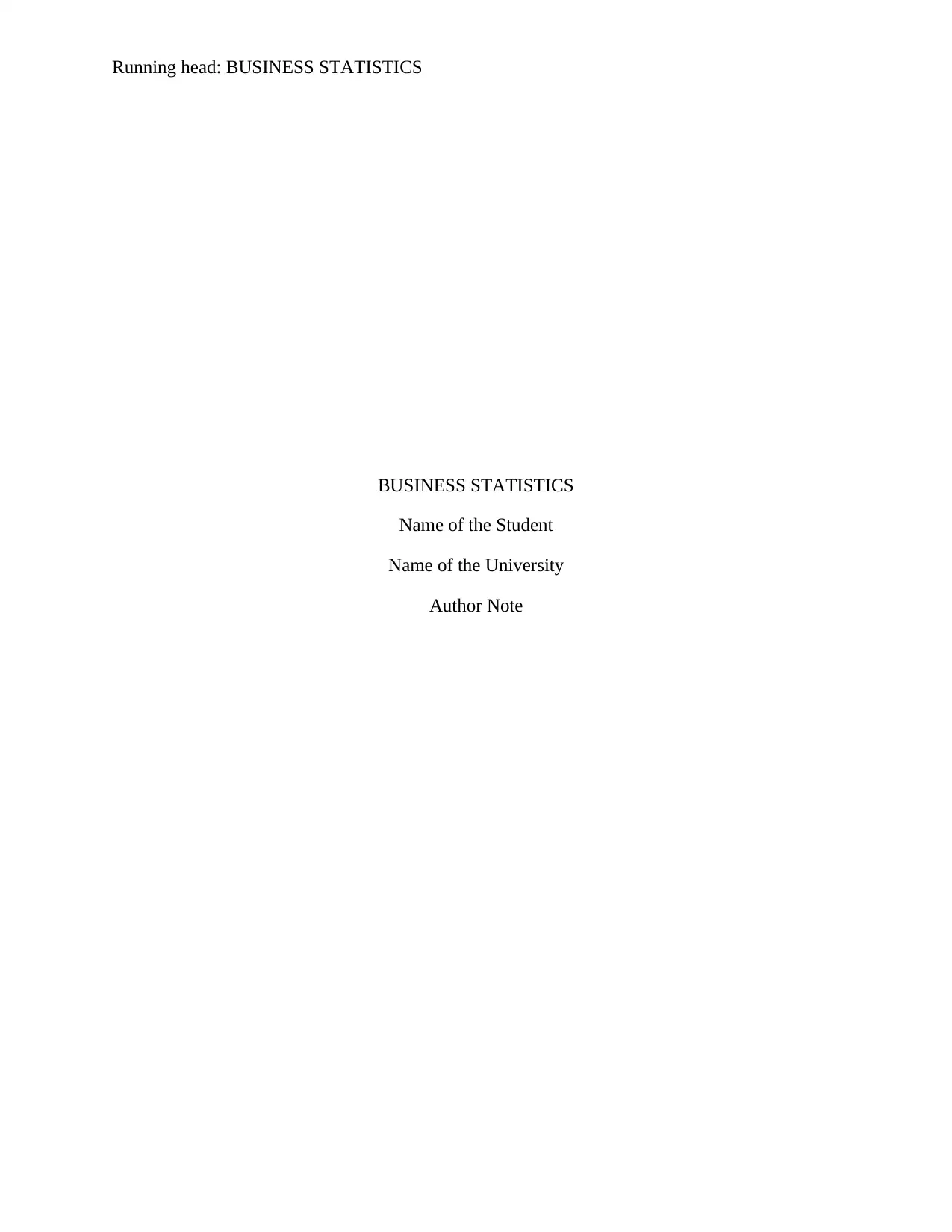
Running head: BUSINESS STATISTICS
BUSINESS STATISTICS
Name of the Student
Name of the University
Author Note
BUSINESS STATISTICS
Name of the Student
Name of the University
Author Note
Paraphrase This Document
Need a fresh take? Get an instant paraphrase of this document with our AI Paraphraser
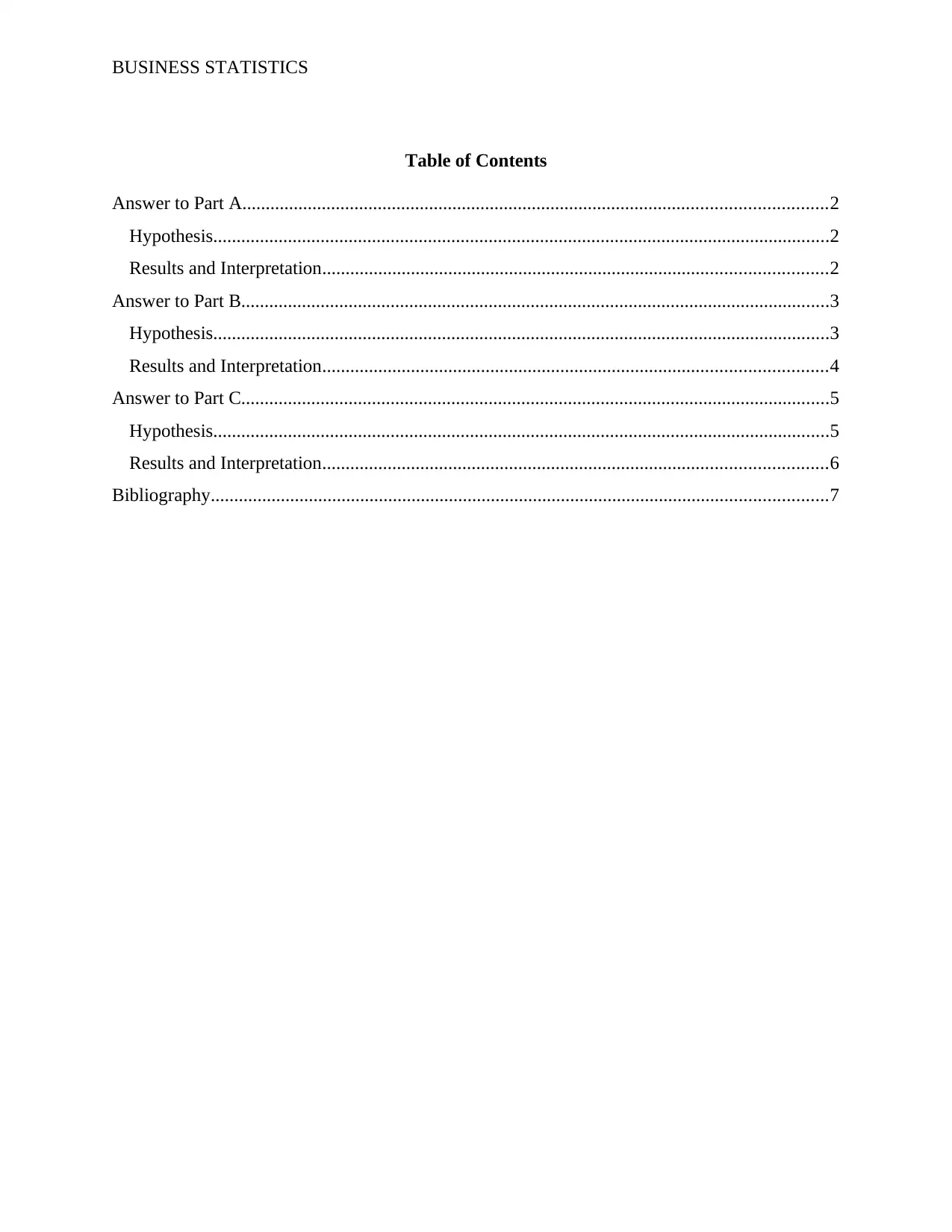
BUSINESS STATISTICS
Table of Contents
Answer to Part A.............................................................................................................................2
Hypothesis....................................................................................................................................2
Results and Interpretation............................................................................................................2
Answer to Part B..............................................................................................................................3
Hypothesis....................................................................................................................................3
Results and Interpretation............................................................................................................4
Answer to Part C..............................................................................................................................5
Hypothesis....................................................................................................................................5
Results and Interpretation............................................................................................................6
Bibliography....................................................................................................................................7
Table of Contents
Answer to Part A.............................................................................................................................2
Hypothesis....................................................................................................................................2
Results and Interpretation............................................................................................................2
Answer to Part B..............................................................................................................................3
Hypothesis....................................................................................................................................3
Results and Interpretation............................................................................................................4
Answer to Part C..............................................................................................................................5
Hypothesis....................................................................................................................................5
Results and Interpretation............................................................................................................6
Bibliography....................................................................................................................................7
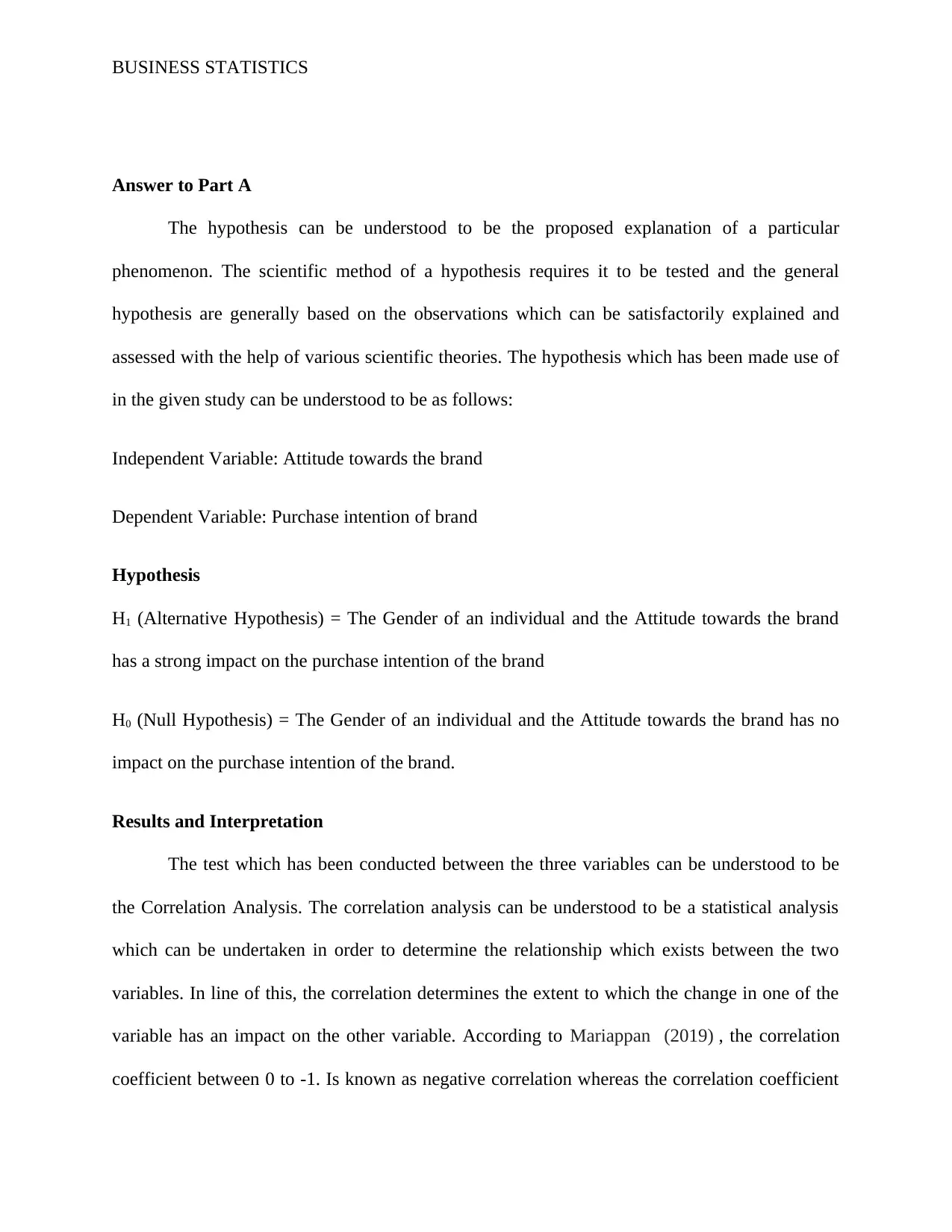
BUSINESS STATISTICS
Answer to Part A
The hypothesis can be understood to be the proposed explanation of a particular
phenomenon. The scientific method of a hypothesis requires it to be tested and the general
hypothesis are generally based on the observations which can be satisfactorily explained and
assessed with the help of various scientific theories. The hypothesis which has been made use of
in the given study can be understood to be as follows:
Independent Variable: Attitude towards the brand
Dependent Variable: Purchase intention of brand
Hypothesis
H1 (Alternative Hypothesis) = The Gender of an individual and the Attitude towards the brand
has a strong impact on the purchase intention of the brand
H0 (Null Hypothesis) = The Gender of an individual and the Attitude towards the brand has no
impact on the purchase intention of the brand.
Results and Interpretation
The test which has been conducted between the three variables can be understood to be
the Correlation Analysis. The correlation analysis can be understood to be a statistical analysis
which can be undertaken in order to determine the relationship which exists between the two
variables. In line of this, the correlation determines the extent to which the change in one of the
variable has an impact on the other variable. According to Mariappan (2019) , the correlation
coefficient between 0 to -1. Is known as negative correlation whereas the correlation coefficient
Answer to Part A
The hypothesis can be understood to be the proposed explanation of a particular
phenomenon. The scientific method of a hypothesis requires it to be tested and the general
hypothesis are generally based on the observations which can be satisfactorily explained and
assessed with the help of various scientific theories. The hypothesis which has been made use of
in the given study can be understood to be as follows:
Independent Variable: Attitude towards the brand
Dependent Variable: Purchase intention of brand
Hypothesis
H1 (Alternative Hypothesis) = The Gender of an individual and the Attitude towards the brand
has a strong impact on the purchase intention of the brand
H0 (Null Hypothesis) = The Gender of an individual and the Attitude towards the brand has no
impact on the purchase intention of the brand.
Results and Interpretation
The test which has been conducted between the three variables can be understood to be
the Correlation Analysis. The correlation analysis can be understood to be a statistical analysis
which can be undertaken in order to determine the relationship which exists between the two
variables. In line of this, the correlation determines the extent to which the change in one of the
variable has an impact on the other variable. According to Mariappan (2019) , the correlation
coefficient between 0 to -1. Is known as negative correlation whereas the correlation coefficient
⊘ This is a preview!⊘
Do you want full access?
Subscribe today to unlock all pages.

Trusted by 1+ million students worldwide
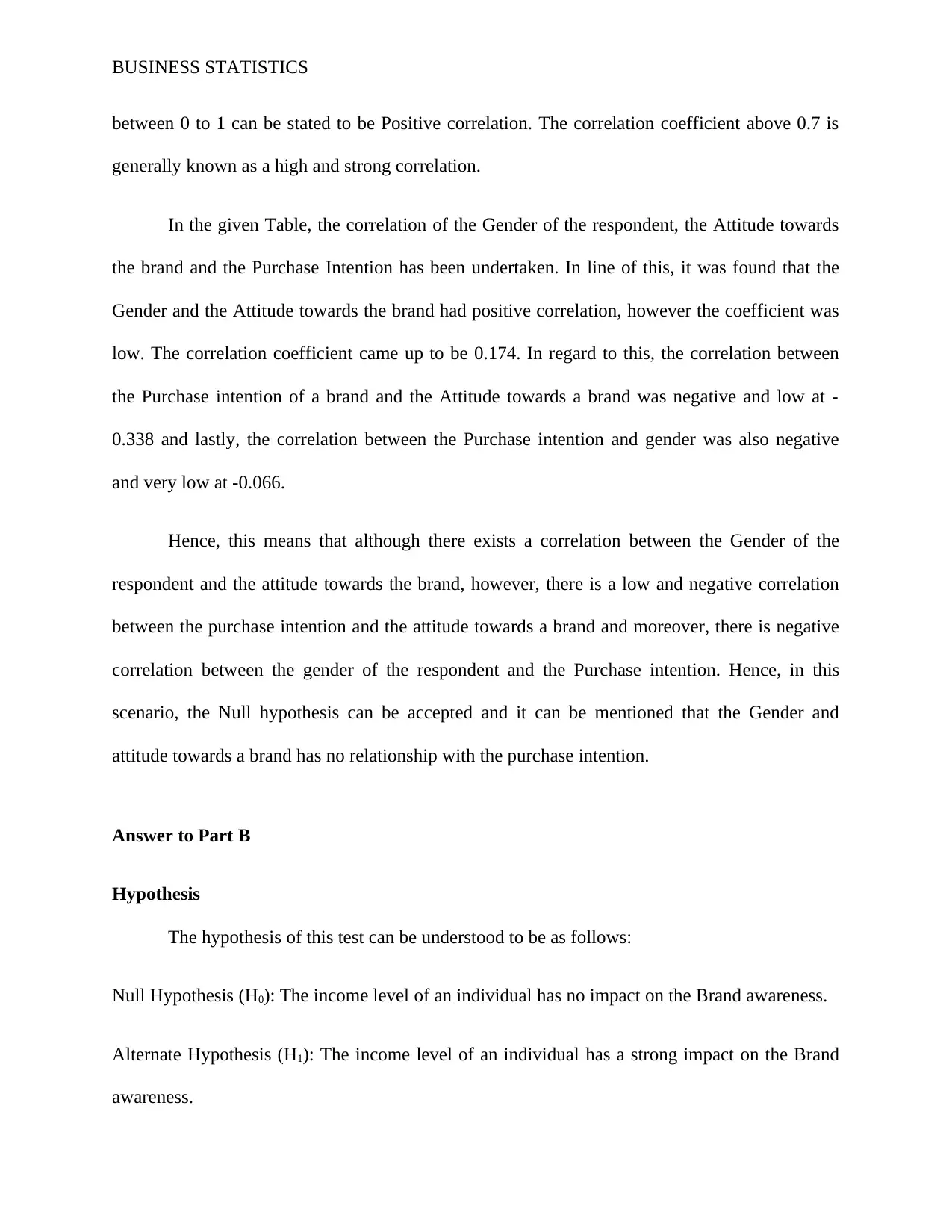
BUSINESS STATISTICS
between 0 to 1 can be stated to be Positive correlation. The correlation coefficient above 0.7 is
generally known as a high and strong correlation.
In the given Table, the correlation of the Gender of the respondent, the Attitude towards
the brand and the Purchase Intention has been undertaken. In line of this, it was found that the
Gender and the Attitude towards the brand had positive correlation, however the coefficient was
low. The correlation coefficient came up to be 0.174. In regard to this, the correlation between
the Purchase intention of a brand and the Attitude towards a brand was negative and low at -
0.338 and lastly, the correlation between the Purchase intention and gender was also negative
and very low at -0.066.
Hence, this means that although there exists a correlation between the Gender of the
respondent and the attitude towards the brand, however, there is a low and negative correlation
between the purchase intention and the attitude towards a brand and moreover, there is negative
correlation between the gender of the respondent and the Purchase intention. Hence, in this
scenario, the Null hypothesis can be accepted and it can be mentioned that the Gender and
attitude towards a brand has no relationship with the purchase intention.
Answer to Part B
Hypothesis
The hypothesis of this test can be understood to be as follows:
Null Hypothesis (H0): The income level of an individual has no impact on the Brand awareness.
Alternate Hypothesis (H1): The income level of an individual has a strong impact on the Brand
awareness.
between 0 to 1 can be stated to be Positive correlation. The correlation coefficient above 0.7 is
generally known as a high and strong correlation.
In the given Table, the correlation of the Gender of the respondent, the Attitude towards
the brand and the Purchase Intention has been undertaken. In line of this, it was found that the
Gender and the Attitude towards the brand had positive correlation, however the coefficient was
low. The correlation coefficient came up to be 0.174. In regard to this, the correlation between
the Purchase intention of a brand and the Attitude towards a brand was negative and low at -
0.338 and lastly, the correlation between the Purchase intention and gender was also negative
and very low at -0.066.
Hence, this means that although there exists a correlation between the Gender of the
respondent and the attitude towards the brand, however, there is a low and negative correlation
between the purchase intention and the attitude towards a brand and moreover, there is negative
correlation between the gender of the respondent and the Purchase intention. Hence, in this
scenario, the Null hypothesis can be accepted and it can be mentioned that the Gender and
attitude towards a brand has no relationship with the purchase intention.
Answer to Part B
Hypothesis
The hypothesis of this test can be understood to be as follows:
Null Hypothesis (H0): The income level of an individual has no impact on the Brand awareness.
Alternate Hypothesis (H1): The income level of an individual has a strong impact on the Brand
awareness.
Paraphrase This Document
Need a fresh take? Get an instant paraphrase of this document with our AI Paraphraser
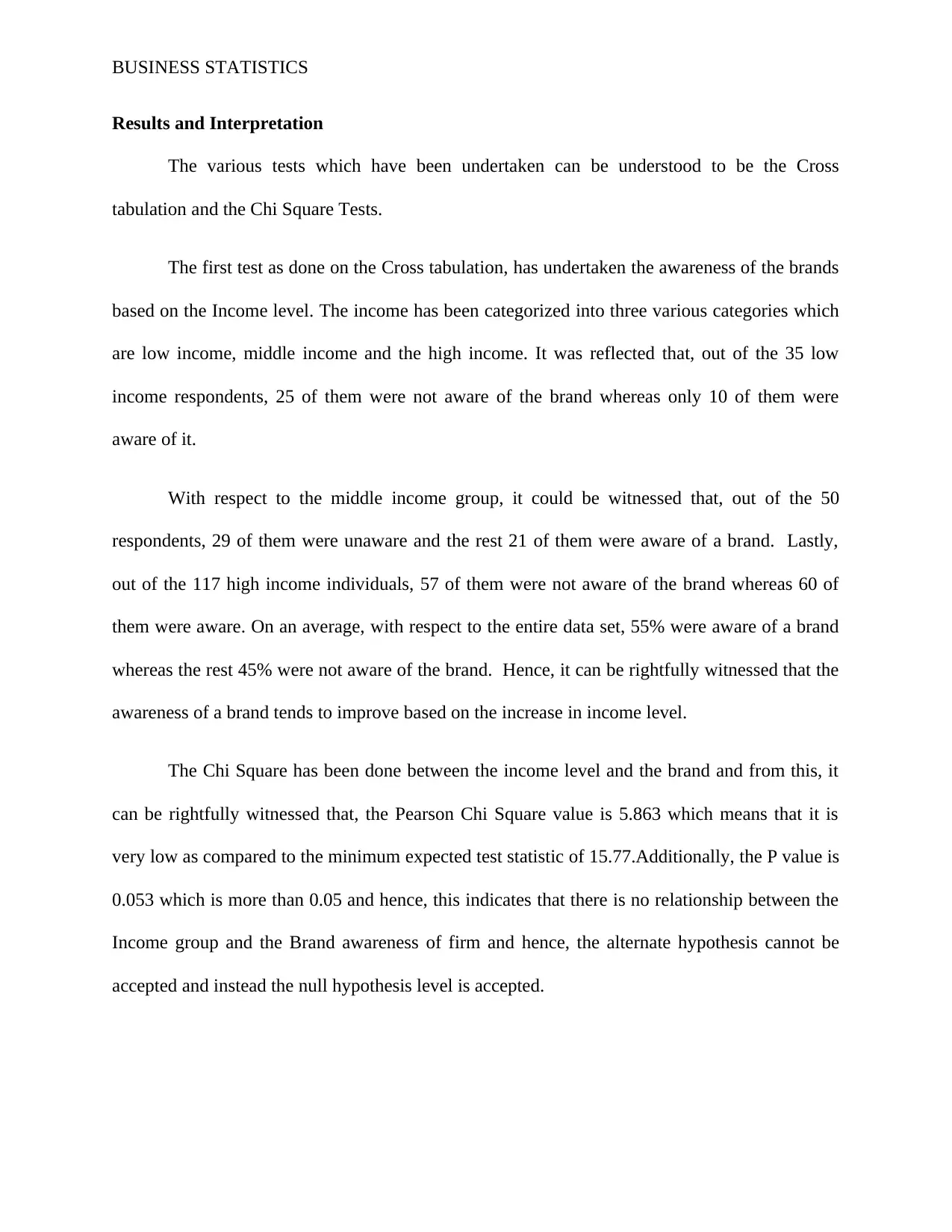
BUSINESS STATISTICS
Results and Interpretation
The various tests which have been undertaken can be understood to be the Cross
tabulation and the Chi Square Tests.
The first test as done on the Cross tabulation, has undertaken the awareness of the brands
based on the Income level. The income has been categorized into three various categories which
are low income, middle income and the high income. It was reflected that, out of the 35 low
income respondents, 25 of them were not aware of the brand whereas only 10 of them were
aware of it.
With respect to the middle income group, it could be witnessed that, out of the 50
respondents, 29 of them were unaware and the rest 21 of them were aware of a brand. Lastly,
out of the 117 high income individuals, 57 of them were not aware of the brand whereas 60 of
them were aware. On an average, with respect to the entire data set, 55% were aware of a brand
whereas the rest 45% were not aware of the brand. Hence, it can be rightfully witnessed that the
awareness of a brand tends to improve based on the increase in income level.
The Chi Square has been done between the income level and the brand and from this, it
can be rightfully witnessed that, the Pearson Chi Square value is 5.863 which means that it is
very low as compared to the minimum expected test statistic of 15.77.Additionally, the P value is
0.053 which is more than 0.05 and hence, this indicates that there is no relationship between the
Income group and the Brand awareness of firm and hence, the alternate hypothesis cannot be
accepted and instead the null hypothesis level is accepted.
Results and Interpretation
The various tests which have been undertaken can be understood to be the Cross
tabulation and the Chi Square Tests.
The first test as done on the Cross tabulation, has undertaken the awareness of the brands
based on the Income level. The income has been categorized into three various categories which
are low income, middle income and the high income. It was reflected that, out of the 35 low
income respondents, 25 of them were not aware of the brand whereas only 10 of them were
aware of it.
With respect to the middle income group, it could be witnessed that, out of the 50
respondents, 29 of them were unaware and the rest 21 of them were aware of a brand. Lastly,
out of the 117 high income individuals, 57 of them were not aware of the brand whereas 60 of
them were aware. On an average, with respect to the entire data set, 55% were aware of a brand
whereas the rest 45% were not aware of the brand. Hence, it can be rightfully witnessed that the
awareness of a brand tends to improve based on the increase in income level.
The Chi Square has been done between the income level and the brand and from this, it
can be rightfully witnessed that, the Pearson Chi Square value is 5.863 which means that it is
very low as compared to the minimum expected test statistic of 15.77.Additionally, the P value is
0.053 which is more than 0.05 and hence, this indicates that there is no relationship between the
Income group and the Brand awareness of firm and hence, the alternate hypothesis cannot be
accepted and instead the null hypothesis level is accepted.
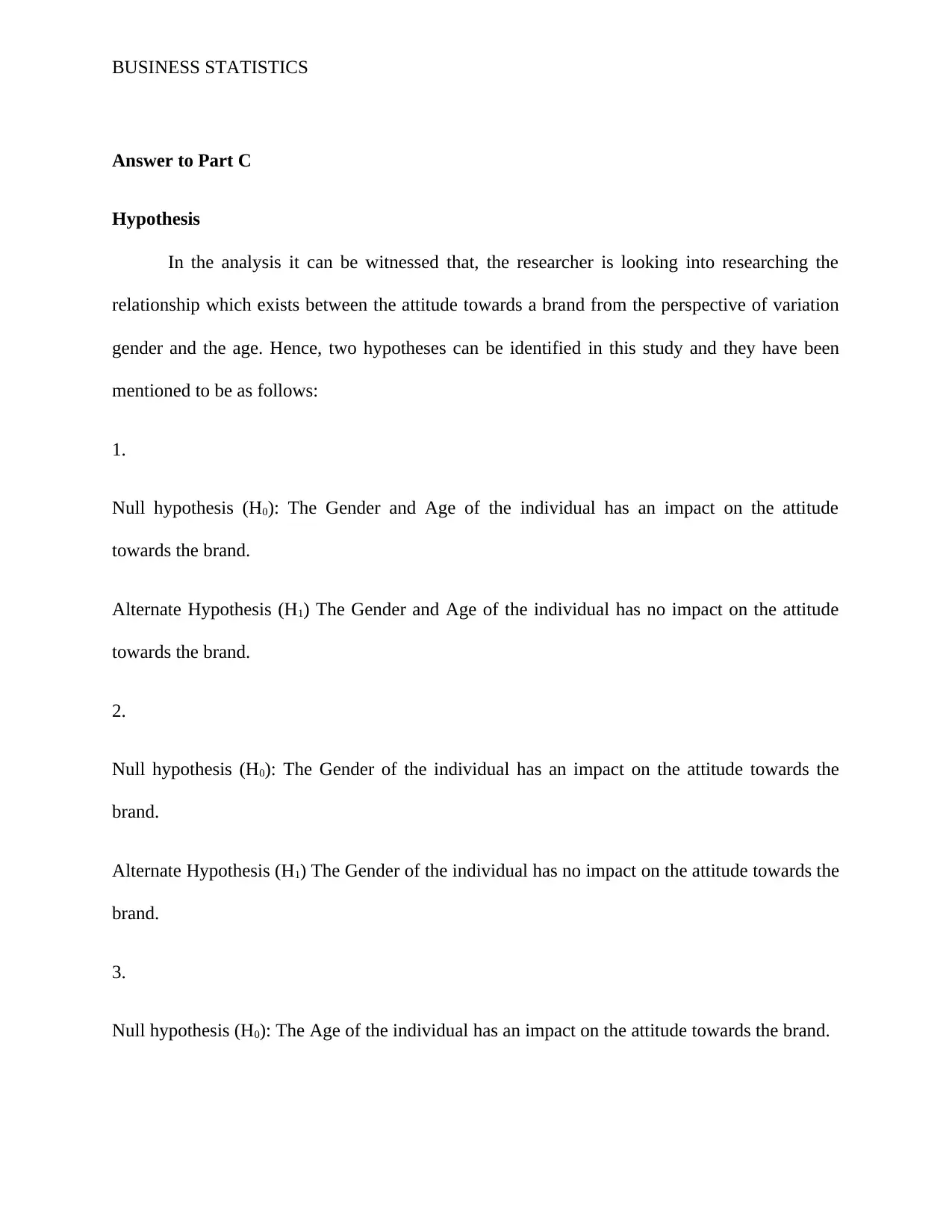
BUSINESS STATISTICS
Answer to Part C
Hypothesis
In the analysis it can be witnessed that, the researcher is looking into researching the
relationship which exists between the attitude towards a brand from the perspective of variation
gender and the age. Hence, two hypotheses can be identified in this study and they have been
mentioned to be as follows:
1.
Null hypothesis (H0): The Gender and Age of the individual has an impact on the attitude
towards the brand.
Alternate Hypothesis (H1) The Gender and Age of the individual has no impact on the attitude
towards the brand.
2.
Null hypothesis (H0): The Gender of the individual has an impact on the attitude towards the
brand.
Alternate Hypothesis (H1) The Gender of the individual has no impact on the attitude towards the
brand.
3.
Null hypothesis (H0): The Age of the individual has an impact on the attitude towards the brand.
Answer to Part C
Hypothesis
In the analysis it can be witnessed that, the researcher is looking into researching the
relationship which exists between the attitude towards a brand from the perspective of variation
gender and the age. Hence, two hypotheses can be identified in this study and they have been
mentioned to be as follows:
1.
Null hypothesis (H0): The Gender and Age of the individual has an impact on the attitude
towards the brand.
Alternate Hypothesis (H1) The Gender and Age of the individual has no impact on the attitude
towards the brand.
2.
Null hypothesis (H0): The Gender of the individual has an impact on the attitude towards the
brand.
Alternate Hypothesis (H1) The Gender of the individual has no impact on the attitude towards the
brand.
3.
Null hypothesis (H0): The Age of the individual has an impact on the attitude towards the brand.
⊘ This is a preview!⊘
Do you want full access?
Subscribe today to unlock all pages.

Trusted by 1+ million students worldwide
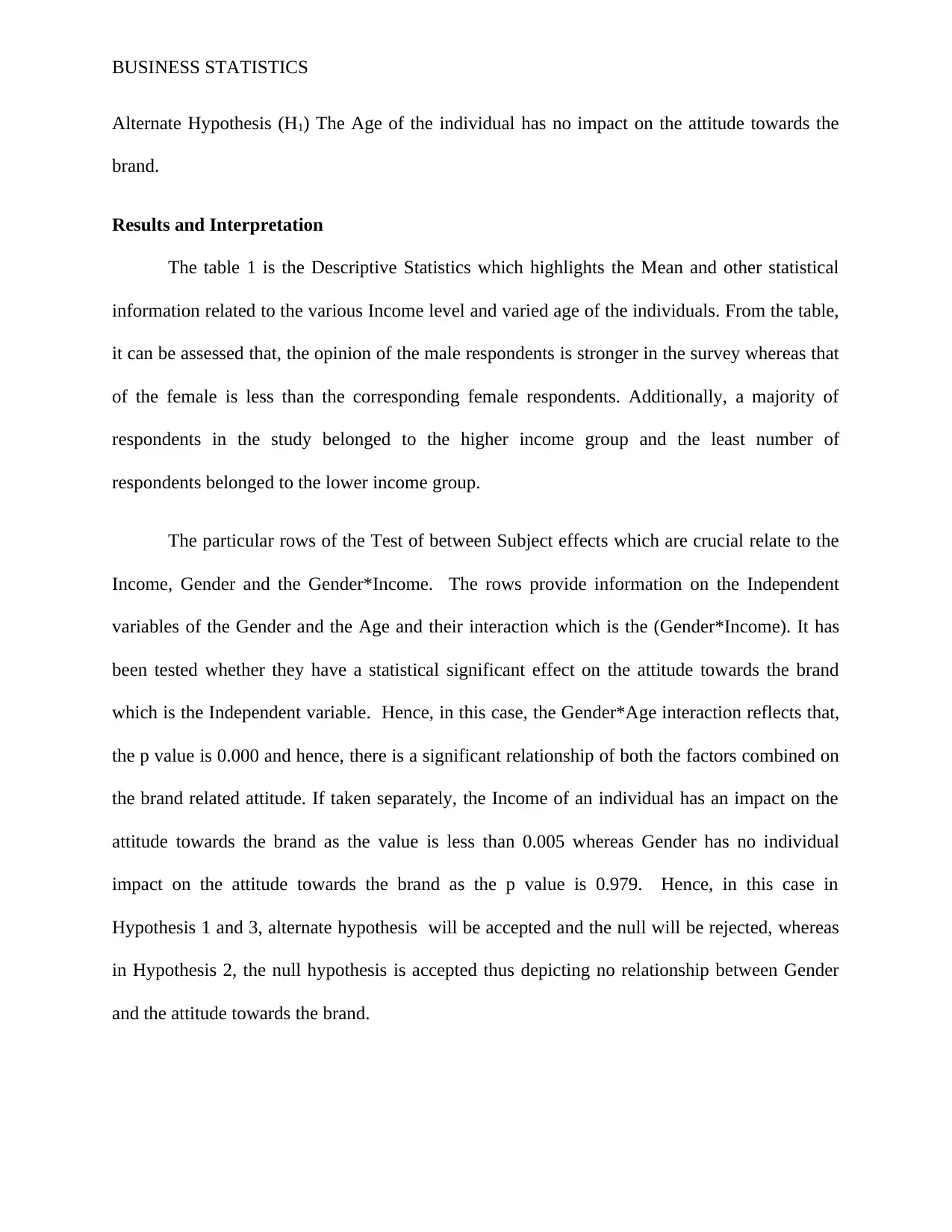
BUSINESS STATISTICS
Alternate Hypothesis (H1) The Age of the individual has no impact on the attitude towards the
brand.
Results and Interpretation
The table 1 is the Descriptive Statistics which highlights the Mean and other statistical
information related to the various Income level and varied age of the individuals. From the table,
it can be assessed that, the opinion of the male respondents is stronger in the survey whereas that
of the female is less than the corresponding female respondents. Additionally, a majority of
respondents in the study belonged to the higher income group and the least number of
respondents belonged to the lower income group.
The particular rows of the Test of between Subject effects which are crucial relate to the
Income, Gender and the Gender*Income. The rows provide information on the Independent
variables of the Gender and the Age and their interaction which is the (Gender*Income). It has
been tested whether they have a statistical significant effect on the attitude towards the brand
which is the Independent variable. Hence, in this case, the Gender*Age interaction reflects that,
the p value is 0.000 and hence, there is a significant relationship of both the factors combined on
the brand related attitude. If taken separately, the Income of an individual has an impact on the
attitude towards the brand as the value is less than 0.005 whereas Gender has no individual
impact on the attitude towards the brand as the p value is 0.979. Hence, in this case in
Hypothesis 1 and 3, alternate hypothesis will be accepted and the null will be rejected, whereas
in Hypothesis 2, the null hypothesis is accepted thus depicting no relationship between Gender
and the attitude towards the brand.
Alternate Hypothesis (H1) The Age of the individual has no impact on the attitude towards the
brand.
Results and Interpretation
The table 1 is the Descriptive Statistics which highlights the Mean and other statistical
information related to the various Income level and varied age of the individuals. From the table,
it can be assessed that, the opinion of the male respondents is stronger in the survey whereas that
of the female is less than the corresponding female respondents. Additionally, a majority of
respondents in the study belonged to the higher income group and the least number of
respondents belonged to the lower income group.
The particular rows of the Test of between Subject effects which are crucial relate to the
Income, Gender and the Gender*Income. The rows provide information on the Independent
variables of the Gender and the Age and their interaction which is the (Gender*Income). It has
been tested whether they have a statistical significant effect on the attitude towards the brand
which is the Independent variable. Hence, in this case, the Gender*Age interaction reflects that,
the p value is 0.000 and hence, there is a significant relationship of both the factors combined on
the brand related attitude. If taken separately, the Income of an individual has an impact on the
attitude towards the brand as the value is less than 0.005 whereas Gender has no individual
impact on the attitude towards the brand as the p value is 0.979. Hence, in this case in
Hypothesis 1 and 3, alternate hypothesis will be accepted and the null will be rejected, whereas
in Hypothesis 2, the null hypothesis is accepted thus depicting no relationship between Gender
and the attitude towards the brand.
Paraphrase This Document
Need a fresh take? Get an instant paraphrase of this document with our AI Paraphraser
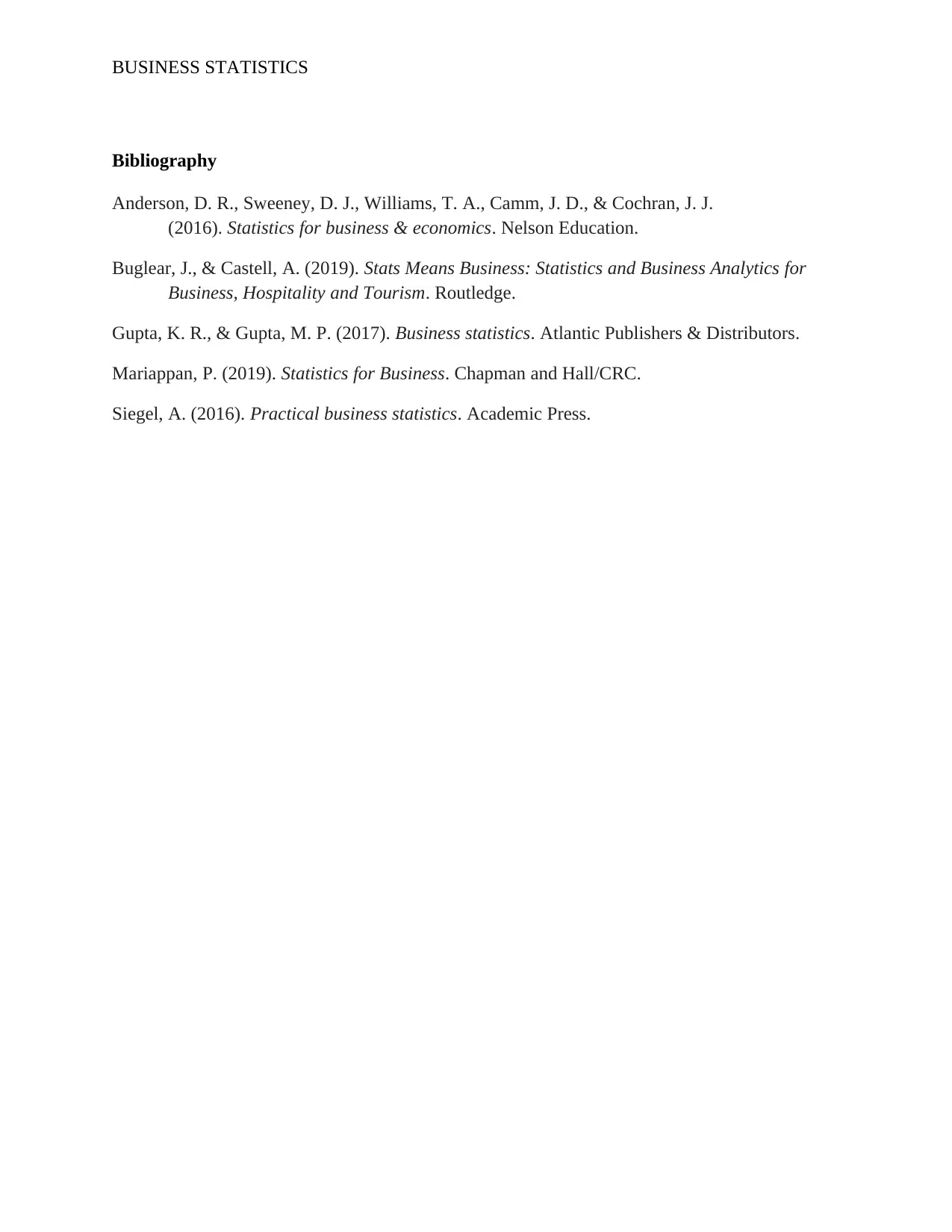
BUSINESS STATISTICS
Bibliography
Anderson, D. R., Sweeney, D. J., Williams, T. A., Camm, J. D., & Cochran, J. J.
(2016). Statistics for business & economics. Nelson Education.
Buglear, J., & Castell, A. (2019). Stats Means Business: Statistics and Business Analytics for
Business, Hospitality and Tourism. Routledge.
Gupta, K. R., & Gupta, M. P. (2017). Business statistics. Atlantic Publishers & Distributors.
Mariappan, P. (2019). Statistics for Business. Chapman and Hall/CRC.
Siegel, A. (2016). Practical business statistics. Academic Press.
Bibliography
Anderson, D. R., Sweeney, D. J., Williams, T. A., Camm, J. D., & Cochran, J. J.
(2016). Statistics for business & economics. Nelson Education.
Buglear, J., & Castell, A. (2019). Stats Means Business: Statistics and Business Analytics for
Business, Hospitality and Tourism. Routledge.
Gupta, K. R., & Gupta, M. P. (2017). Business statistics. Atlantic Publishers & Distributors.
Mariappan, P. (2019). Statistics for Business. Chapman and Hall/CRC.
Siegel, A. (2016). Practical business statistics. Academic Press.
1 out of 8
Related Documents
Your All-in-One AI-Powered Toolkit for Academic Success.
+13062052269
info@desklib.com
Available 24*7 on WhatsApp / Email
![[object Object]](/_next/static/media/star-bottom.7253800d.svg)
Unlock your academic potential
Copyright © 2020–2025 A2Z Services. All Rights Reserved. Developed and managed by ZUCOL.
![Statistics Assignment 2: SPSS Analysis and Report - [University Name]](/_next/image/?url=https%3A%2F%2Fdesklib.com%2Fmedia%2Fimages%2Fin%2F8784072a20714d2aa647583645940fe0.jpg&w=256&q=75)



